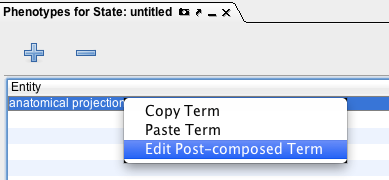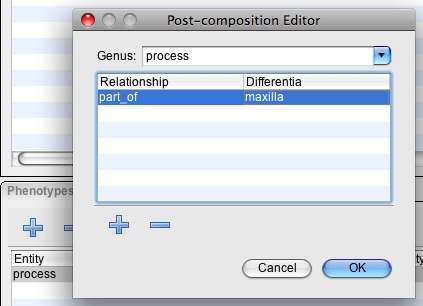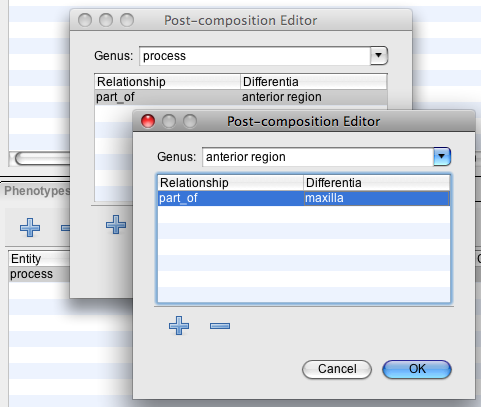Difference between revisions of "Guide to Character Annotation"
(→Genus-differentia definitions) |
(→Genus-differentia definitions) |
||
| Line 198: | Line 198: | ||
Post-composed terms (described below) are terms created on-the-fly at the time of annotation, and take the form of genus-differentia definitions. | Post-composed terms (described below) are terms created on-the-fly at the time of annotation, and take the form of genus-differentia definitions. | ||
| − | + | <!-- | |
test line for commenting out | test line for commenting out | ||
| + | --> | ||
[[Category:Curation]] | [[Category:Curation]] | ||
Revision as of 16:28, 3 April 2009
Contents
PATO terms used for annotation
Curators are currently annotating systematic characters at a coarse level using a small set of quality terms from PATO. These terms represent higher-level terms to describe phenotypic variation, and the Quality field in Phenex is currently limited to these terms.
| PATO term | Synonyms | Character description examples |
|---|---|---|
| shape | triangular, lobed, concave, interdigitated | |
| position | placement, location | horizontal, vertical |
| size | thin, large, decreased height | |
| structure | porous, non-porous | |
| composition | ligamentous | |
| ossified | ||
| cartilaginous | ||
| texture | smooth, wrinkled | |
| color | ||
| relational shape quality* | protruding into | |
| relational spatial quality* | anterior to, lateral to | |
| relational structural quality* | fused with, overlap with, separated from | |
| present in organism | present | |
| absent from organism | absent | |
| count in organism | count |
(*) Relational qualities describe phenotypes between two entities
Character Annotation Examples
The following are examples of character types commonly encountered in the systematic literature and how we annotate them using the EQ model in Phenex. Abbreviations: E, entity; Q, quality, RE, related entity, C, count.
1. Presence/absence
E: pectoral fin, Q: present in organism E: pectoral fin, Q: absent in organsim
If a character describes the presence or absence of a structure located on another entity, (for example, presence of teeth on a particular bone), first check to see whether the structure exists as a term in the TAO before creating a post-composition.
The statement "Teeth absent on basihyal bone" is annotated as:
E: basihyal tooth, Q: absent in organism
2. Well developed vs. small or absent entities
For example, a character involving the auditory foramen is coded with two states: 0, absent or small; 1, well developed.
State 0 is recorded as polymorphic in Phenex:
E: auditory foramen, Q: decreased size E: auditory foramen, Q: absent
State 1 is recorded as:
E: auditory foramen, Q: increased size
3. Use of monadic qualities
Monadic qualities are those that exist in a single entity, such as shape, and do not require another entity. For example, annotation of “sigmoid-shaped supraorbital bone” is entered as:
E: supraorbital, Q: shape
4. Use of relational qualities
Relational qualities are those that exist in an entity but require an additional entity in order to exist. For example, annotation of “parietal fused with supraoccipital” is entered as:
E: parietal, Q: relational structural quality, RE: supraoccipital
5. Annotation involving bone and cartilage terms
Curators should read the character description and examine associated text and figures in the publication to clarify whether the structure referred to is bone or cartilage. In general, the “element” terms should be used sparingly, and only when an author does not indicate whether a structure (e.g. “epibranchial”) is composed of cartilage or bone. The convention for a term like “epibranchial 2” or “basibranchial” is that it is composed of bone and when composed of cartilage an author will say “epibranchial 2 cartilage” or “basibranchial cartilage”, However, this is not universally followed and a curator must read to ascertain this.
Epibranchial 1: (0) present and ossified
E: Epibranchial 1 bone, Q: present
Epibranchial 1: (1) present and cartilaginous
E: Epibranchial 1 cartilage, Q: present
Epibranchial 1: (2) absent
E: Epibranchial 1 cartilage*, Q: absent E: Epibranchial 1 bone*, Q: absent
6. Counts
Characters involving counts of entities are annotated using the “count in organism” quality. Values for counts are entered in the “count” field(*). Note that ranges and lower or upper bounds are recorded as follows:
E: vertebra, Q: count in organism, Count*: 33 E: vertebra, Q: count in organism, Comments*: 34-38 E: vertebra, Q: count in organism, Comments*: >38 E: vertebra, Q: count in organism, Comments*: =/>48
*Note: The Count field in Phenex is currently configured to only accept integer values. Record ranges or min/max values in the Comments field.
Refining terms by post-composition
Oftentimes the need arises to use a more granular term than is already present in the ontology, whether it is the anatomical entity or the quality. For example, to prevent ontology "bloat", regions, margins, and projections of a bone are not in the anatomy ontology, but the bone itself is, and the concepts of margin, relative location of the margin (anterior, posterior, ventral, dorsal, etc), or bony projection are too, or are in other ontologies (spatial aspect, for example). Similarly, the directionality of a phenotype (such as a rotation, or curvature) isn't necessarily present in PATO, but the component terms necessary to express it are. The act of combining terms on-the-fly into cross-product terms is called post-composition, as opposed to pre-composed terms that are already in the ontology.
Post-composed terms can be created in Phenex following the genus-differentia principle of defining terms, where one term serves as the genus, which is then differentiated using a relationship and a differentia term. Unlike pre-composed terms, post-composed terms do not have an ID, and hence are "anonymous." Therefore if the same post-composition is used multiple times, it has the same semantics, but not the same identity. For example, if one wants to assign multiple annotations to the same bony projection of the lateral ethmoid in the same specimen, using post-composed terms does not allow the identity of the anatomical structure between the annotations to be inferred.
The order in which the terms are composed is important if the composition relationship is not reflexive (a relationship is reflexive iff A rel B <=> B rel A). Most relationships are not reflexive. As a general rule, choose the more general part as the genus, and then use the relationship and differentia to narrow down. For example, for "bony projection of the lateral ethmoid" use "bony projection" as the genus, and use the relationship and differentia to narrow down which bony projection of the many that are possible you mean, such as using part_of for the relationship and "lateral ethmoid" as the differentia (formally, the "bony projection that is part_of the lateral ethmoid").
Note that semantically, the post-composed term is equivalent to a pre-composed term, provided the pre-composed term has both the inheritance relationship and the cross-product relationship properly recorded. For example, "bony projection of lateral ethmoid" is-a "bony projection", and "bony projection of lateral ethmoid" part-of "lateral ethmoid".
Refining entity terms on-the-fly
Open the Post-composition Editor box by right-clicking on an empty Entity cell within the "Phenotypes" panel:
Click on “Edit Post-composed Term.” The Editor box should now appear (see below). To post-compose the entity “supraorbital projection”, type “bony projection” in the Genus field, click the “+” button to add a row in the table, type “part_of” in the relationship field, and type “supraorbital” in the differentia field. Click OK.
The post-composed term appears in the Entity field as:
bony projection^part_of(supraorbital bone)
Refining qualities using spatial terms
Often we will want to include spatial information in a post-composed term. The Spatial Ontology is used to post-compose terms related to bone margins, surfaces, or regions. For example, the entity “bony projection on the anterior margin of supraorbital bone” is post-composed as follows:
Within the Post-composition Editor box, type “bony projection” in the genus field and click the “+” button to add relationship = part_of. Right click on the differentia field to create a second post-composed term for "anterior margin of supraorbital bone" (see below). Click the OK button after you have filled out the genus and differentia for this nested composition.
The post-composed term for projection on the anterior margin of frontal appears as:
bony projection^part_of(anterior margin^part_of(supraorbital bone))
As for semantics, identifiability, and rules for post-composing, the same applies as above for entity terms applies to spatial terms. In creating the nested term "anterior margin of supraorbital bone", start with the more general term (for example, the "anterior margin") as the genus, then refine it using a relationship and a differentia term (for example, anterior margin that is part-of the "supraorbital bone").
Specifying the contralateral half of a bilaterally paired structure
Use the spatial term "contralateral" to post-compose entities for the right and left members of a paired structure. For example, a character may describe the posterior processes of the pelvic bone in contact with each other. This would be annotated as:
E: posterior process of basipterygium Q: in contact with RE: contralateral^part_of(posterior process of basipterygium)
Complex size and shape qualities
We are currently annotating complex size and shape characters only to the level of "size" or "shape" for quality. For some characters, entity post-composition can be used to refine size qualities to record details of size differences between states of a character:
Refining size qualities by making them relative
Because size qualities are monadic terms, comparison of size of one bone relative to another requires post-composition of the size quality. For example, the character “frontal length greater than parietal length” is entered as:
E: frontal Q: increased length, relative_to partietal
To post-compose the size quality, type ‘increased length’ in the quality field and click “comp” button. Select ‘relative_to’ in the relationship field and type ‘parietal’ in the differentia field., then click OK. Note that this post-composition follows the same rule of starting with the general terms ("increased length") as the genus, and then refining it with a relationship and a differentia (the increased length that is relative_to the "parietal").
Size qualities with ratio
For the characters in which a proportion or ratio is given in relating the length of one bone to another, the value of ratio is recorded. For example: Length of infraorbital 2: (0) over twice as long as infraorbital 1; (1) less than twice as long as infraorbital 1. This would be indicated in Phenex as follows:
E: infraorbital 2, Q: increased length, relative_to: infraorbital 1, Measurement: >2, Unit: ratio E1: Infraorbital 2, Q: decreased length, relative_to: infraorbital 1, Measurement: <2, Unit: ratio
The qualities are post-composed.
Evidence Codes
We record phenotype descriptions as properties of species, and annotations are assigned one of three evidence codes based on the level of evidence given by an author for phenotype observations. These specimen evidence codes are in an Evidence Codes Ontology that was developed by the broader biological community (see http://obofoundry.org/cgi-bin/detail.cgi?id=evidence_code). We have added evidence codes to this ontology, and we use the following in order below from strong to weak evidence.
Inferred from Voucher Specimen (IVS)
Used when an annotation is made on the basis of a phenotype description for a species or higher level group that is given by an author who explicitly references an observation of a voucher specimen(s). Voucher specimens are defined as those specimens with permanent museum catalog numbers. Thus it would be possible for a person to examine this particular specimen and observe the annotated phenotype.
- Note: if there is a matrix in the paper, the IVS evidence code is assigned to all annotations linked to the character list.
Traceable Author Statement (TAS)
The TAS evidence code covers author statements that are attributed to a cited source. Typically this type of information comes from review articles. Material from the introductions and discussion sections of non-review papers may also be suitable if another reference is cited as the source of experimental work or analysis. When annotating with this code the curator should use caution and be aware that authors often cite papers dealing with experiments that were performed in organisms different from the one being discussed in the paper at hand. Thus a problem with the TAS code is that it may turn out from following up the references in the paper that no experiments were performed on the gene in the organism actually being characterized in the primary paper. For this reason we recommend (when time and resources allow) that curators track down the cited paper and annotate directly from the experimental paper using the appropriate experimental evidence code. When this is not possible and it is necessary to annotate from reviews, the TAS code is the appropriate code to use for statements that are associated with a cited reference. Once an annotation has been made to a given term using an experimental evidence code, we recommend removing any annotations made to the same term using the TAS evidence code.
Nontraceable Author Statement (NAS)
The NAS evidence code should be used in all cases where the author makes a statement that a curator wants to capture but for which there are neither results presented nor a specific reference cited in the source used to make the annotation. The source of the information may be peer reviewed papers, textbooks, database records or vouchered specimens.
How to write definitions for ontology terms
Genus-differentia definitions
Term definitions in the teleost anatomy ontology (TAO) take the form of genus-differentia definitions: B is an A that has X. The term B is defined by its membership in higher category A and distinguished from its sibling terms by characteristic X. The following are examples of genus-differentia definitions in the TAO:
Antorbital: Dermal bone that is located on the anterior margin of the infraorbital series, dorsal to the first infraorbital and lateral to the nasal bone.
Dentary: Dermal bone that forms the anterolateral part of the lower jaw.
In example 1, the definition mentions the parent dermal bone of the term antorbital, followed by the characteristics that differentiate antorbital from all other dermal bones.
Post-composed terms (described below) are terms created on-the-fly at the time of annotation, and take the form of genus-differentia definitions.


